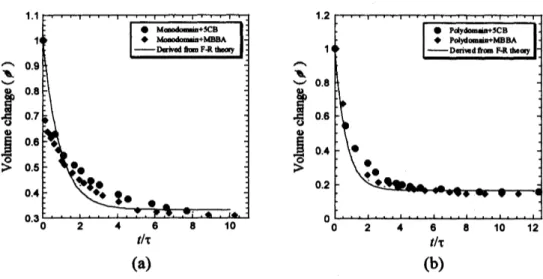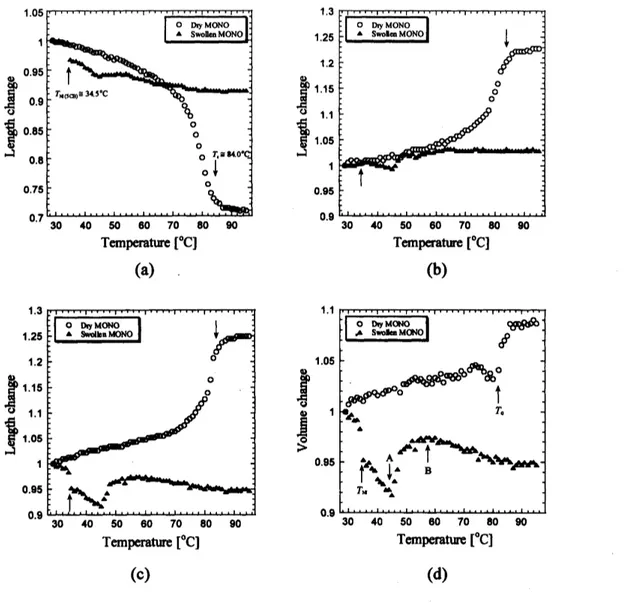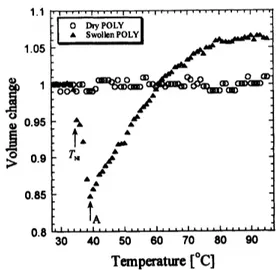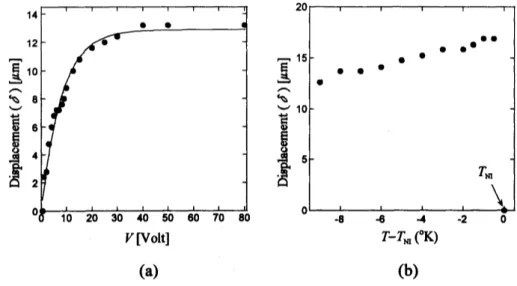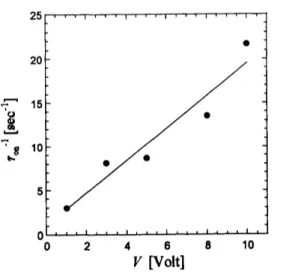Swelling behavior
liquid crystal elastomers
in
lowmolecular weight liquid crystals
YusrilYUSUF,Yukitada ONO Yusuke SUMISAKI and Shoichi KAI
Department Applied Physics, Faculty
of
EngineeringKyushu University, Fukoka812-8581, Japan
Weexperimentally investigated the swelling behavior of liquid crystal elastomers(LCEs)
intwoanisotropic solvents suchaslowmolecular weight liquid crystals,$5\mathrm{C}\mathrm{B}$and MBBA.
Thelength of LCEs by swellingexpandedmorethan 1.8 timesofits initial length which
depended on the director orientation. The volume change of swollen LCEs has been
investigated as function oftemperature and several phase transitions were observed in
both optical and adifferential scanning calorimetry measurements. ElectrO-mechanical
effects of swollen LCEs were also investigated in detail and drastic decrease of the
criticalfield forelectr0-mechanical effects, 1/4000 lower than dryLCEs,wasobtained.
Introduction
LCEs and gels presently attract much attention due to the volume and shape
changing properties caused by several environmental factors, such
as
solvent composition,temperature, ionic strength, $\mathrm{p}\mathrm{H}$, light, electric field, etc. [1]. LCE materials studied here is
invented and developed by Heino Finkelmann and $\mathrm{c}\mathrm{o}$-workers at Freiburg University,
Germany. The behavior of these materials arises ffom
a
coupling between the elasticproperties of the polymer chains network and the liquid-crystalline ordering of
monomeric
mesogen groupsas
the side chains. The polymer chains network is formed by added thecross-linkingagents to the systemofpolymer chains. There
are
two typicaldomains of LCEsdepending
on
the directororientation
(the director $\mathrm{n}$ is definedas
the average direction of theliquid-crystalline ordering of side chains consisting of mesogenic groups). One is the
s0-called polydomain, when the mesogenic
groups
are
macroscopically disordered in theliquid crystalline state. The other is the s0-called monodomain, when the mesogenic groups
are
macroscopicallyorderedinthe liquid crystalline state.Most of the earlier studies
are
concentratedon
theswelling effect ofgels in isotropicsolvent, but few studies
on
the swelling effect of anisotropic material (i.e. LCEs) inanisotropic solvents (low molecular weight liquid crystals; LLCs). Swelling behavior of
polymernetwork in liquid crystal (LC) solvents has been investigated in early study by
some
数理解析研究所講究録 1305 巻 2003 年 139-148
researchers $[2, 3]$
.
They investigated temperature dependence of the degree of equilibriumswelling and phasethe behavior of LC inthe systemconsisting ofLC and polymer network.
In the present study,
we
investigated temperature dependence of volume changes of swollenLCEs in LLCs in detail.
Additionally, spontaneous shape change of oriented side chains LCEs(monodomain)
at the nematic-isotropicphase transition is firstly found by$\mathrm{P}.\mathrm{E}$
.
Cladis [4]. She conclude thatthe resultgave “proofof concept” to the idea of LCEs
as
artificial muscles when cooperativeorientation effects of the side chains(i.e. thephasetransition)extendedbeyond atypicalmesh size ofthecross-linked polymer network. To check her$\mathrm{i}\mathrm{d}\mathrm{e}*$ inthis study,
we
deal with shapechange of swollen LCEs with LLCs under
an
alternating electric fieldas
wellas
its
temperaturedependence.
Experimental Samples
LCEs, both polydomain and monodomain,
were
synthesized by Heino Finkelmanngroup
at Freiburg University in Germany. The samplesare
prepared by polymer analoguereaction of poly(methyl-hydrogen-siloxane) with
an
average degree of polymerization ofabout 60 and the monomeric
mesogen
4-buten0xy-4’-methyl0xy benzoid acid phenylester$(\mathrm{C}\mathrm{H}2=\mathrm{C}\mathrm{H}-\mathrm{C}\mathrm{H}2-\mathrm{C}\mathrm{H}2-\mathrm{O}-\mathrm{p}\mathrm{h}\mathrm{e}\mathrm{n}\mathrm{y}\mathrm{l}-\mathrm{C}\mathrm{O}\mathrm{O}-\mathrm{p}\mathrm{h}\mathrm{e}\mathrm{n}\mathrm{y}\mathrm{l}-\mathrm{C}\mathrm{H}3)$ and the cross-linking agent
(H2$=\mathrm{C}\mathrm{H}-\mathrm{O}-(\mathrm{S}\mathrm{i}(\mathrm{C}\mathrm{H}3)_{2}-\mathrm{O})_{12}-\mathrm{C}\mathrm{H}=\mathrm{C}\mathrm{H}2$). The cross-linker agent is the oligomeric
Poly(dimethylsiloxane)with the terminal vinyl
groups.
The concentrationof the cross-linkingis 8%relatedto thereactivevinyl groups. Except the chemistry of the cross-linking agentthe
procedure of the synthesis is described in [8]. The monodomain sample is mechanically
loaded after gelation(after 3hours)to obtain the director orientation. Under these conditions
the cross-linking reaction is completed. These anisotropy
was
optically tested to confirmdirectororientationusing
cross
polarizers. In orderto check the anisotropic swelling behaviorthese samples,
we
preparedthreetypes LCE samples withdifferentgeometries against bulkdirector orientations $\mathrm{n}$
.
One is obtained by slicing parallel to $\mathrm{n}$, another by slicingperpendicular to$\mathrm{n}$andthe last
one
isapolydomain film. Hereafterwe
call these MONOI (i.e.planar alignment film), MONO2 (homeotropic alignment film) and POL. All samples
were
sliced to thin film with the dimension of about 1.0
mm
in height, 0.5mm
in width and 150$|\mathrm{m}$ in thickness. We here define the$x$and$y$-directions
as
parallel and perpendicularto $\mathrm{n}$on a
plane respectively, and the$\mathrm{z}$-direction is perpendicular toboth$\mathrm{n}$ and theplane.
Samples
are
embedded intheanisotropic swelling solvents. In this studywe
use
twokind of LLCs, 4-n-phentyl-4’-cyan0biphenyl $(5\mathrm{C}\mathrm{B})$ and
4’-meth0xy-benzilidene-4-buthyl-aniline (MBBA)
Measurements
After sliced, LCE samples
are
embedded in anisotropic solvent between two $\mathrm{S}\mathrm{i}\mathrm{O}$surface glass plates. The thickness
was
controlled by apolymer (Mylar) spacer of 350 $\mu \mathrm{m}$.
The swelling behavior
was
observed in apolarizing microscope (Nikon) equipped with thehot stage (Mettler Teledo FP90 Central Processor)
as
temperature control whichcan
simultaneously
measure
its thermal property (heat capacity) by adifferential scanningcalorimetry (DSC). The length expansion rate $(\alpha_{i})$ by swelling is defined
as
the ratio oftheswollenlength$l_{i}(t)$ to the initial length$l_{i0}$where$i=x,y$and$z$
.
The
electric-mechanical
measurementswere
preparedby madean
electr0-0ptical cell consisting oftwo transparent ITO electrodes with very clean $\mathrm{S}\mathrm{i}\mathrm{O}$ surface thatwas
treatedtobe homeotropic alignment for $5\mathrm{C}\mathrm{B}$ and MBBA and applied
an
alternating electric fieldperpendicularly to theelectrodes [$\mathrm{E}=$(0,0,Ez)] at fixed temperature.
Results anddiscussion
SWelling
effect
Fig. 1shows the temporal dimensionchanges during swellingprocessofthreetypes
of slices in the low molecular weight liquid crystal $5\mathrm{C}\mathrm{B}$
.
The time $t=0$ is atime justembedding LCE into $5\mathrm{C}\mathrm{B}$
.
Fig. la shows variation the swelling rate of MONOI. In $x$direction (perpendicular to the director n) the length expansion rate % $(=lJl_{x\mathit{0}})$ increases
exponentially intimeand saturates with the values about 1.8 after 60 minutes. Contrastto this,
% is constant and
no
length change is observed. That is, in the direction parallel to thedirectororientation,
no
swellingoccurs.
(a) (b) (c)
Figure 1. Temporal length changes during swelling process of MONOl(a),
MONO2 (b) and POLY(c) in $5\mathrm{C}\mathrm{B}.(\bullet)$ the length expansion rates in x-direction
(a), (A)thelength expansionrates in$y$-direction(ay). See textfor detail
In Fig.$1\mathrm{b}$, the length changes of MON02 by swelling
are
shown. Both$\alpha_{x}$ and $\alpha_{y}$ increase exponentially in time and saturate with the maximum value about $1.8\pm 0.1$
.
In thefilm the directorof LCE is homeotropic, there is
no
specific directionto expand inthe plane.Thus it clearly shows that avolume expansion ofmonodomain LCE by swelling with $5\mathrm{C}\mathrm{B}$
indicates anisotropic property depending
on
directions to the director orientation inMONO-LCE.
Similar results to MONO2
can
be observed for POLY as shown in Fig. $1\mathrm{c}$, that is,both $\alpha_{x}$ and %increase in time and saturates with about $1.8\pm 0.1$
.
Inthe POLYcase
unlikewith MON02 the dimension$l_{z}$in$z$direction similarly expands in timeto other directionwith
the rate 1.8. Thus apolydomain LCE equally expands in all directions
as
in isotropic gels.Similarbehavior
was
observed for swelling MBBA replacing $5\mathrm{C}\mathrm{B}$.
Fig. 2shows the volume changes ($) of monodomain and polydomain during
swelling process in $5\mathrm{C}\mathrm{B}$ and MBBA. Where $\emptyset$is the averaged mol ffactionfor all directions
as
afirst step of analysis though both LCEs and LLCsare
anisotropic. $\tau$ is the arbitraryrelaxation time, experimentally obtained as, for monodomain: 15.57 $\min(5\mathrm{C}\mathrm{B})$, 29.58 $\min$
(MBBA), and for polydomain: 8.10 $\min(5\mathrm{C}\mathrm{B})$, 6.04 $\min$ (MBBA). The volume ffaction is
defined
as
the ratio ofthe LCE volumes in the swelling process $\mathrm{V}\{\mathrm{f}$) and dry $V_{0}$ thatwas
calculated ffom the average length changes of the swollen LCE and dry LCE using
a
relation $\phi=l_{0}^{3}/l(t)^{3}$
.
The solid lineinthe figureisthe resultof theoretical calculation derivedffomthe Flory-Rehner theory(isotropic gels) [9],
$\mathrm{r}(\mathrm{d}\psi \mathrm{d}\mathrm{t})$$\cong(1/\emptyset)[\phi+\ln(1-\phi)+\chi\beta+v\phi^{1/3}]$ (1)
$\ovalbox{\tt\small REJECT}\wedge[searrow]\check{\mathrm{o}\mathrm{r}\iota}$ $\ovalbox{\tt\small REJECT}\wedge[searrow] v\mathrm{o}$
.
$\frac{\ovalbox{\tt\small REJECT}\triangleleft l}{>0}$ $\frac{\xi 4l}{>^{\mathrm{O}}}$
(a) (b)
Figure 2. Volume changes during swelling process of monodomain and
polydomain in $5\mathrm{C}\mathrm{B}$ and MBBA. The solid line indicates the theoretical
curve(Eq. 1)
$\tau$is acertain time constant, $\chi$is the Flory-Huggins interaction parameter.
$v=n_{\mathrm{c}}\nu_{\mathrm{c}}/V_{0}$, where
$n_{\mathrm{c}}$ and $v_{\mathrm{c}}$ are number of partial chain in the LCE and volume of
one
lattice elementrespectively. $\emptyset$ decreases exponentially in time in both swollen monodomain LCE (Fig.
$2\mathrm{a}$)
and swollen polydomain LCE (Fig. $2\mathrm{b}$). The swelling
process
for both with $5\mathrm{C}\mathrm{B}$ and MBBAshows similar tendency. It may indicate aform for the ffee energy between the LCEs-5CB
mixture and of the LCEs-MBBA mixture has
no
difference. There issome
deviations of theexperimental dataffomthe theoretical
curve
(1) (solid line inFig.2)basedon
isotropicgels. Itis probably duetoanisotropic properties of both LCEs and LLCs.
Temperature dependence of the dimension changes ofdry and swollen monodomain
samples
are
shown in Fig.3.
Here, the volume change $V(D$ is normalized by the LCEvolumes in the equilibrium swollen state $V_{\mathrm{s}}$ at
room
temperature. The typical of lengthchanges in $x$, $y$ and $z$ directions
are
shown in Fig.4*
$\mathrm{b}$ and $\mathrm{c}$ respectively. Increasingtemperature, with rating of about$0.7^{\mathrm{o}}\mathrm{C}/\mathrm{s}\mathrm{e}\mathrm{c}$, dry monodomaingradually shrinks in x-direction
(parallel to the director) by around $T_{\mathrm{c}}=84^{\mathrm{o}}\mathrm{C}$ which is thenematic-isotropic phase
transition
temperature of dry LCE. In contrast, LCE stretches in $y$ and $z$-directions(both
are
perpendicularto thedirector) whenitis heated up. Closeto $T_{\mathrm{c}}$, drastic changes of lengths for
all direction
are
observed owing to phase transition. The length change at $T_{\mathrm{c}}$ however in alldirection disappeared for swollenLCE and
no
change isobtainedas seen
in Figs. 3* $\mathrm{b}$ and $\mathrm{c}$.
Instead, for example with $5\mathrm{C}\mathrm{B}$, abig change for all direction is observed atnematic-isotropic
transition of$5\mathrm{C}\mathrm{B}(\mathrm{r}\mathrm{N}\mathrm{I}\cong 34.5^{\mathrm{o}}\mathrm{C})$
.
In Fig. $3\mathrm{d}$, temperature dependence ofthe volume changes of monodomain LCE is
shown. Increasing temperature, the volume changes in dry sample slightly increase almost
linearly till $80^{\mathrm{o}}\mathrm{C}$
.
Close to Tc, abig expansion of the volumeoccurs
owing to itsnematic-isotropic transition and then saturates wit the value about 1.08. It is known that the
isotropic gels show
no
volume changes with increasing temperature. This result clearlyindicates that the phase transition of LCE plays
an
important role in the temperaturedependenceofthe volume changes inthemonodomainsample.
On the other hand, drastic difference for swollen LCEs ffom dry samples
can
beobserved. There exists almost
no
changeof the length in$x$-direction in swollen LCE excepta
jump indicating its shrink at $T_{\mathrm{N}1}$ of $5\mathrm{C}\mathrm{B}$ and avery small dip at $T_{\mathrm{A}}\cong 45^{\mathrm{o}}\mathrm{C}$
.
Iny-direction,however, the length changeis also small but different ffomin$x$-direction. There is
no
changeat $T_{\mathrm{N}1}$atall but smalljumpindicating elongationat $T_{\mathrm{A}}$
.
However, the length change of$z$-direction has avariety. There is abigjump in the
change indicating shrinkat $T_{\mathrm{N}1}$, intemperaturebetween $T_{\mathrm{N}1}$ and $T_{\mathrm{A}}$considerable decrease, and
around $T_{\mathrm{B}}$again jumpindicating elongation. Wedonot yetunderstand thesemechanismsfor
shrinking and elongating. Duetothese anomalouschanges in$x,y$and$z$-directions,the volume
change shows complicate temperature dependence
as sown
in $\mathrm{F}\mathrm{i}\mathrm{g}.3\mathrm{d}$.
According to the DSCTmperatlre$[^{\mathrm{o}}\mathrm{C}]$ $\mathrm{T}\mathrm{m}\mathrm{p}\mathrm{e}\mathrm{r}\mathrm{a}\mathrm{t}\iota \mathrm{r}\mathrm{e}$$[^{\mathrm{o}}\mathrm{C}]$
(a) (b)
Temperature$[^{\mathrm{o}}\mathrm{C}]$ Tempelatlm $[^{\mathrm{o}}\mathrm{C}]$
(c) (d)
Figure3. Dependence of volume changes ofdry and swollen monodomain
LCEs on temperature (d). (a) typical length change in $x$-direction, (b) in
$y$-direction,(c)in$z$-direction. See text for detail.
measurement, asharp peakis observed at $T_{\mathrm{N}1}$ and two broad and small bumps
are
obtainedat$T_{\mathrm{A}}$ and $T_{\mathrm{B}}$
.
It therefore suggests that some phase transition mayoccur.
At thismoment
however,
we
do not determine what those phasesare.
To determine these unknown statesmore
investigation is necessary.Temperature dependence of the volume changes in polydomain LCE is shown in
Fig.5. Unlike the
case
ofdry monodomain sample, the volume change of adry sample doesnot show anybig change at $T_{\mathrm{c}}$ and the volumeis constant
over
wholetemperature range. It issimilar to isotropicgels andtherefore polydomainLCE could be
an
isotropic elastomer. Abigvolume change
occurs
however for swollen polydomain. Two big shrinksare
observed at $T_{\mathrm{N}1}$$(5\mathrm{C}\mathrm{B})(\cong 34.5^{\mathrm{o}}\mathrm{C})$ and $T_{\mathrm{A}}\cong 39.0^{\mathrm{o}}\mathrm{C}$, heating further the volume increases by
near
$T_{\mathrm{c}}$144
Temperature$[^{\mathrm{o}}\mathrm{C}]$
Figure4.Dependence of volume changesofdry
andswollen polydomain LCEsontemperature.
(nematic-isotropic transitiontemperature ofLCE). According to DSC measurements, similar
peak and bump
are
observed butmore
investigationwillbe required.ElectrO-mechanical
effects
Applying
an
electric fieldto the swollen LCEs withLLCs,LLC molecules willeasilyrearrangetheirorientationparallel to the fields. This
electr0-mechanical
effect is mediated bymobile LLCs ffee to
move
in and out ofthe LCEs, the LC side chains could communicatewith each other
on
length scales extending beyond atypical mesh size of the cross-linkedpolymer network, then aweak electric field, rather than temperature changes, could also
trigger aspontaneous shape change. The investigations in shape changes of liquid-crystalline
polymers by electric fields
were
reported bysome
researchers. In 1986, Zentel [6] reportedhis observation
on
shape variation of cross-linked liquid-crystalline polymers, whichare
swollen with nematic LLCs, by electric fields. Subsequently, Barnes et al. [6] reported their
largest shape change of about 20%
contraction
ofan
elastomer swollen in $6\mathrm{C}\mathrm{B}$(cyanohexyl-biphenyl) when both elastomer and $6\mathrm{C}\mathrm{B}$
were
isotropic. Later, in1994
Kishi etal. [7] reported the quantitativeresults of shape changes ofswollen polydomain LCEs under
acting
a
dc electric field, $\mathrm{E}=0.3\mathrm{M}\mathrm{V}/\mathrm{m}$.
Belowwe
will describedour
resent resultson
thissubject.
Asliced polydomain film (the thickness is 20 $\mu \mathrm{m}$)
was
embedded in$5\mathrm{C}\mathrm{B}$ (after
swelling sample expands to about $\sim 40\mu \mathrm{m}$) to observe the electr0-mechanical effects.
Spontaneous shape changes
were
observed whenan
alternating electric field appliedperpendicularly to the electrodes. In Fig.
5*
thevariation
of shape changes (determined by20
.
..
$\overline{\underline{\Xi \mathrm{a}}}15$.
$\cdots$.
.
$\nwarrow\wedge$.
10 $\dot{5}$$.A^{\mathrm{o}}\ovalbox{\tt\small REJECT}\ovalbox{\tt\small REJECT} 5$
-2 $T_{\mathrm{N}\mathrm{I}\backslash _{0}}$ 0 $\nabla[\mathrm{V}\mathrm{o}1\mathrm{t}]$ -8 $- 64T-T_{\mathrm{N}1}(^{\mathrm{o}}\mathrm{K})$ (a) (b)
Figure 5. ElectrO-mechanical effect of swollen polydomain LCE.
Displacement versusapplied voltage(V)at $T=26^{\mathrm{o}}\mathrm{C}$isexpressedin(a),
(b)temperaturedependenceof$\delta$ in field$([=50\mathrm{H}\mathrm{z}, V=50\mathrm{V})$
.
Seetextfor detail.
displacement $\delta$of sample shape ffom itsequilibrium swollen state) ffom
zero
voltsposition isshown. Temperatureis controlledat$26^{\mathrm{o}}\mathrm{C}$
.
The solid lineisafit to:$X0$ $=12\mathrm{J}8$ $[1-\exp(V/7.97)]$ (2)
Increasing voltage, with fixed ffequency($f=50\mathrm{H}\mathrm{z}$ , the shape changeincreases and saturates
with themaximumvalue about 13 $\mu \mathrm{m}$
.
According to the fitting, saturation is about$20\mathrm{V}$.
Thethresholdvoltageis about 1.OV, 1/4000times smallerthanthat ofdryLCE.
Fig. $5\mathrm{b}$ shows temperature dependence of shape change in field ($f=50\mathrm{H}\mathrm{z}$ and $V=$
$50\mathrm{V})$
.
As temperature is increased, shape change increases slightly. Maximum contraction isachieved at temperature just before the nematic-isotropic phase transition. In the isotropic
phase,
no
displacementswere
observed.The spontaneous shape changes ofswollen LCEs
are
induced by thereorientation ofanisotropic solvent molecules inside the LCE. This reorientation influences many mesogenic
side chains cooperatively which inturnreorienttochange the network shape making itthicker
along $\mathrm{E}$ and thinner perpendicular to E. Since in the isotropic phase the reorientation of
solvent molecules could not occurs, it does not driving the shape change. Though $5\mathrm{C}\mathrm{B}$ is
isotropic, the mesogenic side chains
are
still in nematicphase until about $84^{\mathrm{o}}\mathrm{C}$ that it is stillpossibleto contractionbutshouldbe appliedinhigh voltage $(\sim 4000\mathrm{V})$
.
$-_{1}-.\underline{-n_{8}\Phi 0}\mathrm{b}$
Figure 6. Voltage dependence of inverse
relaxation time of swollen polydomain
LCEwhen thefield isswitched“on”.
Fig. 6shows applied voltage dependence of the relaxation times when the field is
switched “on”. Increasing the voltage, the inverse of relaxation time increase monotonically
(linear
or
probably square). Above 10 $\mathrm{V}$, the image analysis could notbe done,becauseofthelimitation of
our
image software (NIH-Image). Theresponse
ofspontaneous shape changesspeed less than asecond when the fieldis switchedoff.
Summary and Conclusions
Wehave presented in this studythe swellingbehaviorof LCEs with LLCs and found
thefollowingfacts.
(1) The swellingprocess maybe described by the Flory-Rehnertheory.
(2)The complex volume changes of swollen LCEs
are
observed,whichmayindicate avarietyofdifferentphase
transitions.
Howeverto determinethemmore
detailed studiesare
necessary.
(3) The threshold field for electr0-mechanical effects has been lowered by swollen LCEs of
whichvaluebecomes 1/4000times smallerthanthat ofdry LCEs.
Finally
we
would like to mention about the mechanism of the volume changes bytemperature. Due to rubber elasticity ofLCEs, elevating temperature dry LCEs may shrink
with strong elasticity. Therefore if there
are
no
other effects like phasetransitions ofsolventsand LCEs, the volume ofdry LCEs is basically either constant
or
monotonically shrinking.Theexperimental facts such
as
jumpsof the volume changeare
duetothe interactionchangesbetween LCE networks and solvents LLCs by phase transitions. Also increasing elasti
constants, LCEs exclude absorbing LLCs. The detailed mechanisms
are
left in future works.Wewould like to thank Profs. P. Cladis, H. Finkelmann and H. R. Brandfor supplying LCEs,
manyvaluable suggestionsanddiscussions.
References
[1]. M. Shibayama and T. $\mathrm{T}\mathrm{a}\mathrm{n}\mathrm{a}\mathrm{k}*" \mathrm{P}\mathrm{h}\mathrm{a}\mathrm{s}\mathrm{e}$ Transition and Related Phenomena of Polymer
Gels”,ResponsiveGels: Volume Transition1Springer-Verlag, Berlin, 109, 1,(1993).
[2]. K. Urayama, M. De Sarkar, T. Kawamura and S. $\mathrm{K}\mathrm{o}\mathrm{h}\mathrm{j}\mathrm{i}\mathrm{y}*ICR$ Annual Report, 6, 8
(1999).
[3].K. Urayama, Z.Luo, T.Kawamuraand S. $\mathrm{K}\mathrm{o}\mathrm{h}\mathrm{j}\mathrm{i}\mathrm{y}*Chem$
.
Phys.Lett, 287,342
(1998).[4]. P. E. Cladis, “Liquid Crystalline Elastomer
as
Artificial Muscles”, Dynamic ControlSystem
Conference
(Aug1999
Ottawa, Canada)Proceedings,Arde Guran,2001.
[5]. J.Kupfer, H. Finkelmann,Macrocom. Chem. Phys., 195, 1353 (1994).
[6]. R.Zentel,Liq. Cryst.,1,
589
(1986).[7].N. R. Barnes,F. J. Davisand G. R.Mitchell,Mol Cryst. Liq. Cryst., 168, 13 (1989).
[8].R.Kishi, Y. Suzuki,H. Ichijo and O. $\mathrm{H}\mathrm{i}\mathrm{r}\mathrm{a}\mathrm{s}*$Chem. Lett. (Japan),pp. 2257-2260(1994).
[9].M. Doi,IntroductiontoPolymerPhysics,Oxford UniversityPress,p. 63 (1997)

